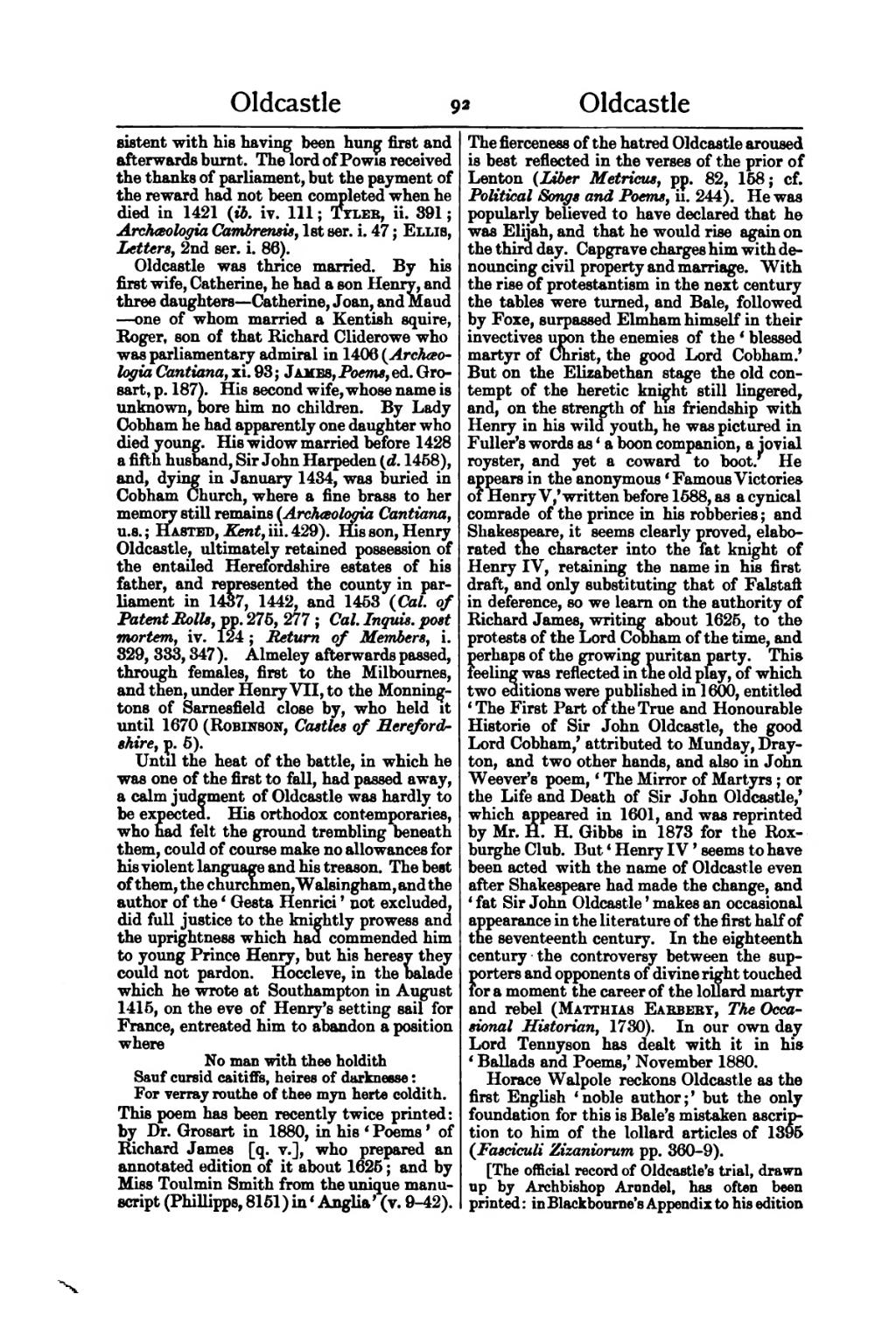sistent with his having been hung first and afterwards burnt. The lord of Powis received the thanks of parliament, but the payment of the reward had not been completed when he died in 1421 (ib. iv. Ill; Tyler, ii. 391; Archæologia Cambrensis, 1st ser. i. 47 ; Ellis, Letters, 2nd ser. i. 86).
Oldcastle was thrice married. By his first wife, Catherine, he had a son Henry, and three daughters—Catherine, Joan, and Maud —one of whom married a Kentish squire, Roger, son of that Richard Cliderowe who was parliamentary admiral in 1406 (Archæologia Cantiana, xi. 93; James, Poems, ed. Grosart, p. 187). His second wife, whose name is unknown, bore him no children. By Lady Cobham he had apparently one daughter who died young. His widow married before 1428 a fifth husband, Sir John Harpeden (d. 1458), and, dying in January 1434, was buried in Cobham Church, where a fine brass to her memory still remains (Archæologia Cantiana, u.s.; Hasted, Kent, iii. 429). His son, Henry Oldcastle, ultimately retained possession of the entailed Herefordshire estates of his father, and represented the county in parliament in 1437, 1442, and 1453 (Cat. of Patent Rolls, pp. 275, 277 ; Cal. Inquis. post mortem, iv. 124 ; Return of Members, i. 329, 333, 347). Almeley afterwards passed, through females, first to the Milbournes, and then, under Henry VII, to the Monningtons of Sarnesfield close by, who held it until 1670 (Robinson, Castles of Herefordshire, p. 5).
Until the heat of the battle, in which he was one of the first to fall, had passed away, a calm judgment of Oldcastle was hardly to be expected. His orthodox contemporaries, who had felt the ground trembling beneath them, could of course make no allowances for his violent language and his treason. The best of them, the churchmen, Walsingham, and the author of the' Gesta Henrici' not excluded, did full justice to the knightly prowess and the uprightness which had commended him to young Prince Henry, but his heresy they could not pardon. Hoccleve, in the balade which he wrote at Southampton in August 1415, on the eve of Henry's setting sail for France, entreated him to abandon a position where
No man with thee holdith
Sauf cursid caitiffs, heires of darknesse:
For verray routhe of vheo myn herte coldith.
This poem has been recently twice printed: by Dr. Grosart in 1880, in his 'Poems' of Richard James [q. v.], who prepared an annotated edition of it about 1625 ; and by Miss Toulmin Smith from the unique manuscript (Phillipps, 8151) in' Anglia' (v. 9-42). The fierceness of the hatred Oldcastle aroused is best reflected in the verses of the prior of Lenton (Liber Metricus, pp. 82, 158; cf. Political Songs and Poems, ii. 244). He was popularly believed to have declared that he was Elijah, and that he would rise again on the third day. Capgrave charges him with denouncing civil property and marriage. With the rise of protestantism in the next century the tables were turned, and Bale, followed by Foxe, surpassed Elmham himself in their invectives upon the enemies of the 'blessed martyr of Christ, the good Lord Cobham.' But on the Elizabethan stage the old contempt of the heretic knight still lingered, and, on the strength of his friendship with Henry in his wild youth, he was pictured in Fuller's words as' a boon companion, a jovial royster, and yet a coward to boot. He appears in the anonymous 'Famous Victories of Henry V,' written before 1588, as a cynical comrade of the prince in his robberies; and Shakespeare, it seems clearly proved, elaborated the character into the fat knight of Henry IV, retaining the name in his first draft, and only substituting that of Falstaft in deference, so we learn on the authority of Richard James, writing about 1625, to the protests of the Lord Cobham of the time, and perhaps of the growing puritan party. This feeling was reflected in the old play, of which two editions were published in 1600, entitled 'The First Part of the True and Honourable Historie of Sir John Oldcastle, the good Lord Cobham,' attributed to Munday, Drayton, and two other hands, and also in John Weever's poem, 'The Mirror of Martyrs; or the Life and Death of Sir John Oldcastle,' which appeared in 1601, and was reprinted by Mr. H. H. Gibbs in 1873 for the Roxburghe Club. But 'Henry IV' seems to have been acted with the name of Oldcastle even after Shakespeare had made the change, and 'fat Sir John Oldcastle' makes an occasional appearance in the literature of the first half of the seventeenth century. In the eighteenth century the controversy between the supporters and opponents of divine right touched for a moment the career of the lollard martyr and rebel (Matthias Earbery, The Occasional Historian, 1730). In our own day Lord Tennyson has dealt with it in his 'Ballads and Poems,' November 1880.
Horace Walpole reckons Oldcastle as the first English 'noble author;' but the only foundation for this is Bale's mistaken ascription to him of the lollard articles of 1395 (Fasciculi Zizaniorum pp. 360-9).
